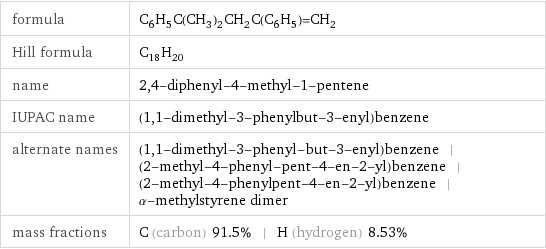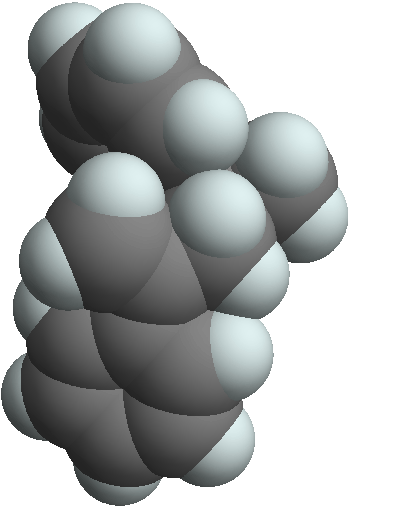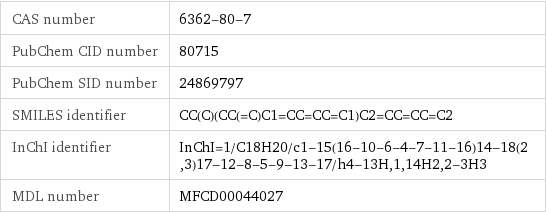Input interpretation

2, 4-diphenyl-4-methyl-1-pentene
Chemical names and formulas

formula | C_6H_5C(CH_3)_2CH_2C(C_6H_5)=CH_2 Hill formula | C_18H_20 name | 2, 4-diphenyl-4-methyl-1-pentene IUPAC name | (1, 1-dimethyl-3-phenylbut-3-enyl)benzene alternate names | (1, 1-dimethyl-3-phenyl-but-3-enyl)benzene | (2-methyl-4-phenyl-pent-4-en-2-yl)benzene | (2-methyl-4-phenylpent-4-en-2-yl)benzene | α-methylstyrene dimer mass fractions | C (carbon) 91.5% | H (hydrogen) 8.53%
Lewis structure

Draw the Lewis structure of 2, 4-diphenyl-4-methyl-1-pentene. Start by drawing the overall structure of the molecule, ignoring potential double and triple bonds: Count the total valence electrons of the carbon (n_C, val = 4) and hydrogen (n_H, val = 1) atoms: 18 n_C, val + 20 n_H, val = 92 Calculate the number of electrons needed to completely fill the valence shells for carbon (n_C, full = 8) and hydrogen (n_H, full = 2): 18 n_C, full + 20 n_H, full = 184 Subtracting these two numbers shows that 184 - 92 = 92 bonding electrons are needed. Each bond has two electrons, so in addition to the 39 bonds already present in the diagram add 7 bonds. To minimize formal charge carbon wants 4 bonds. Identify the atoms that want additional bonds and the number of electrons remaining on each atom: Fill in the 7 bonds by pairing electrons between adjacent highlighted atoms. Note that the six atom rings are aromatic, so that the single and double bonds may be rearranged: Answer: | |
3D structure

3D structure
Basic properties

molar mass | 236.36 g/mol phase | liquid (at STP) boiling point | 161 °C (measured at 666.5 Pa) density | 0.99 g/cm^3
Units

Liquid properties (at STP)

density | 0.99 g/cm^3 refractive index | 1.569
Units

Chemical identifiers

CAS number | 6362-80-7 PubChem CID number | 80715 PubChem SID number | 24869797 SMILES identifier | CC(C)(CC(=C)C1=CC=CC=C1)C2=CC=CC=C2 InChI identifier | InChI=1/C18H20/c1-15(16-10-6-4-7-11-16)14-18(2, 3)17-12-8-5-9-13-17/h4-13H, 1, 14H2, 2-3H3 MDL number | MFCD00044027
Safety properties

flash point | 110 °C